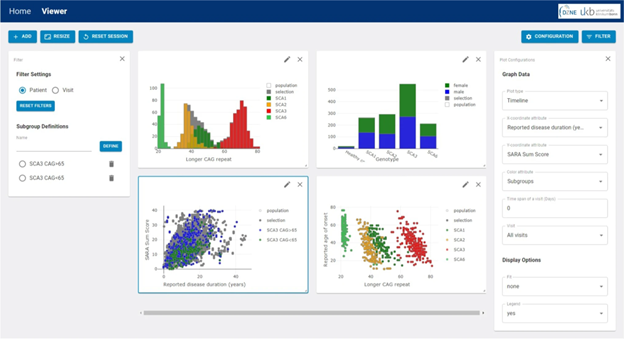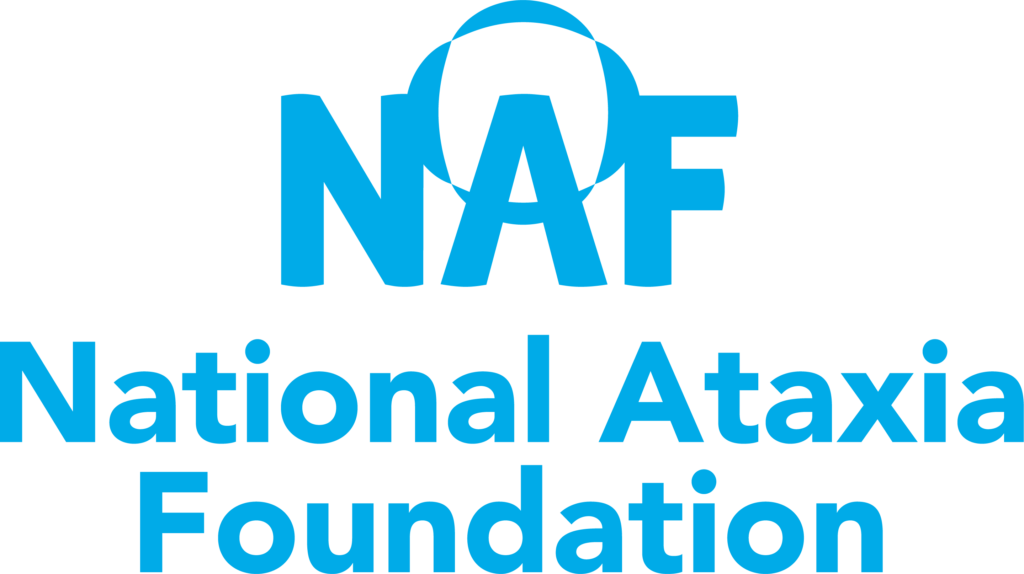
Written by Dr. Celeste Suart
Edited by Priscila Pereira Sena
An international group of researchers developed a new tool for looking at large datasets of spinocerebellar ataxia clinical information.
Spinocerebellar ataxias (SCAs) are the most common form of dominantly inherited ataxia worldwide. Since SCAs are rare diseases, it can be hard to find the large number of patient participants needed to do clinical research. It can also be a challenge to try to compare or combine clinical data from smaller studies on ataxia. A free new online tool, SCAview, solves this problem for researchers.
The team behind SCAview compiled data from multiple ongoing observational studies into one tool. Observational studies are when someone’s ataxia symptoms are measured over time, but there is no experimental treatment being tested. The goal of observational studies is to learn how symptoms change over time.
The combined data in SCAview is the biggest dataset on ataxia made so far. SCAview has clinical data from 1,417 people. This includes:
- 264 people with SCA1
- 297 people with SCA2
- 551 people with SCA3
- 206 people with SCA6
- 99 unaffected volunteers
Since observational studies collect data over time, SCAview has information from the same people over multiple years. There is data from over 5,500 visits! Some of the information included in SCAview consists of the person’s CAG repeat length, the age when the person had their first symptoms, their biological sex, and their SARA clinical score.

A screenshot of what the SCAview tool looks like. This example has all the data shown. Researchers can use the control panels on the left and right of the screen to filter the data and only look at specific entries. The image is taken from the research article being summarized (Uebachs et al., Cerebellum, 2023) under a Creative Commons Attribution 4.0 International License.
One thing that the researchers were concerned about when designing SCAview was participant privacy. They did not want any one person to be identifiable from their associated data on SCAview. They implemented several measures to protect participant privacy, such as not providing exact birthdates or dates of visits, or including the name of the study from which the data was obtained. This was done to ensure that SCAview meets the requirements of the General Data Protection Regulation (GDPR), the guideline in the European Union on data privacy and sharing personal information.
The creation of SCAview is only the first step. Now that this tool exists, researchers will be able to use it to identify patterns within clinical data. These patterns can be used to better understand how ataxia symptoms happen over time and brainstorm new research questions. Also, the research team behind SCAview has built it to be able to grow. As more clinical data on ataxia is collected, it can also be incorporated into the SCAview system. This includes additional information from participants who are already in SCAview, as well as new participants.
Overall, SCAview is a new ataxia research tool for scientists and clinicians. It will help researchers to see patterns in clinical data from over 1,400 ataxia patients and unaffected volunteers. This solves the problem of having a small number of people participating in research, by collecting the available information together into one larger group. SCAview is the first online tool to accomplish this.
Key Words
General Data Protection Regulation (GDPR): The privacy and security law in the European Union. It is a list of regulations that companies must follow regarding the data privacy of individuals and the sharing of personal information online.
Observational study: Also called a natural history study, an observational study is a type of clinical trial where someone’s symptoms are measured over time. Unlike interventional studies, there is no experimental treatment being tested in observational studies. Instead, researchers are most interested in measuring how someone’s symptoms change over time without any kind of treatment.
Conflict of Interest Statement
The writer and editor of this article are members of the Ataxia Global Initiative, a group of ataxia researchers from around the world who work together to advance ataxia research. The Ataxia Global Initiative supported the development of SCAview.
The writer and editor were not involved with the creation of SCAview or the writing of the scientific journal article which is summarized.
Citation of Article Reviewed
Uebachs, Mischa, et al. “SCAview: an Intuitive Visual Approach to the Integrative Analysis of Clinical Data in Spinocerebellar Ataxias.” The Cerebellum (2023): 1-9. https://link.springer.com/article/10.1007/s12311-023-01546-0
Read Other SCAsource Summary Articles

¿Ser o no ser SCA27B? Esa es la cuestión: Misteriosos casos de ataxia resueltos gracias a los avances en tecnología genética
Escrito por Dr. Hayley McLoughlin y Dr. Sharan SrinivasanEditado por Dr. Celeste SuartTraducido por Ismael Araujo-Aliaga Una nueva tecnología de secuenciación genética reveló numerosos casos de ataxia familiar asociados a Read More…


Interrupciones en las repeticiones están asociadas con ataques epilépticos en SCA10
Escrito por Dr Hannah ShorrockEditado por Larissa NitschkeTraducido por Ismael Araujo-Aliaga Interrupciones en las repeticiones en SCA10 influyen en la estabilidad del tramo repetido y están asociadas con ataques epilépticos Read More…


Genetic variants in the NPTX1 gene cause cerebellar ataxia
Written by Dr. Hannah K Shorrock Edited by Dr. Celeste Suart Three genetic variants in the NPTX1 gene have been linked to cerebellar ataxia, providing a genetic diagnosis for seven Read More…









